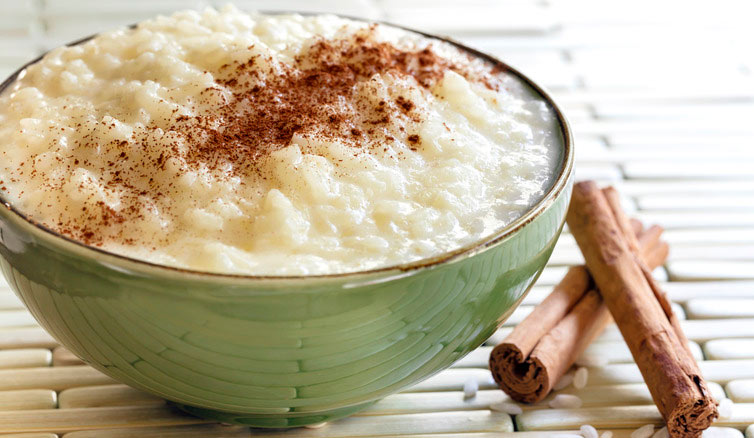 Rice pudding by any other name might be known as risengrød, which is a staple of Greenlandic (and Danish) Christmas celebrations; arroz con leche, a cinnamon-flavored Mexican dessert (here's one Mashed recipe developer's take on it), or kheer, a South Asian rice pudding that tastes of cardamom and coconut milk and may be studded with raisins and pistachios. In Greece, however, rice pudding goes by the name of rizogalo and in its most basic form is not too dissimilar from the standard American version of this universal dessert.
Rice pudding by any other name might be known as risengrød, which is a staple of Greenlandic (and Danish) Christmas celebrations; arroz con leche, a cinnamon-flavored Mexican dessert (here's one Mashed recipe developer's take on it), or kheer, a South Asian rice pudding that tastes of cardamom and coconut milk and may be studded with raisins and pistachios. In Greece, however, rice pudding goes by the name of rizogalo and in its most basic form is not too dissimilar from the standard American version of this universal dessert.
Rizogalo may not be quite as well known as other Greek dishes such as souvlaki, moussaka, or baklava, but it is still the kind of thing you might find on a menu at the homier sort of Greek restaurant. Rice puddings all over the world, after all, are pretty much the epitome of comfort food: easy to make and even easier to eat.
History of rizogalo
As rice pudding is pretty global, it's kind of hard to pinpoint exactly when it arrived in Greece and who brought the recipe. For all we know, it could have been just about any Greek cook who found themselves with leftover rice and thought, hmm, what would happen if I mix in some cream and sugar? Still, people love origin stories that are a bit more elaborate than anonymous person + leftovers, so rizogalo does have a few competing backstories.
The oldest of these stories dates back to some unspecified date between 1453 and 1821. Oddly specific dates, yes, but this is the period when Greece was occupied by the Turks of the Ottoman Empire. If these colonial rulers were the ones to introduce the dish, this would explain any similarities between rizogalo and its Turkish counterpart, sutlac. (Well, that and the fact that most rice puddings tend to be fairly similar.) Yet another claim, however, is that rizogalo dates to later in the 19th century when French cooking became popular in Greece, as the French, you guessed it, have a rice pudding of their own called riz au lait. There's even a third story relating how refugees from Anatolia (which is now part of Turkey) brought the idea of a rice-based pudding to Greece when they showed up in the early 1920s. As far as possible influencers go, looks like the Turks are ahead of the French by a score of 2 to 1.
How is rizogalo made?
Rizogalo starts off with cooked rice, so yes, it can be, and probably often is, made with leftovers (although one would hope they've been safely stored since leftover rice can be dangerous if it isn't properly cooled and reheated). Cooks who start from scratch, however, may favor using arborio rice or a similar starchy, short-grained variety.
Once the rice is cooked, milk or cream and sugar are added and then it cooks some more. Other common additions to the rice pudding include cornstarch to thicken it up and cinnamon, vanilla extract, or citrus zest (lemon, orange, or both) to flavor it. Some cooks also like to add eggs for extra richness, but others prefer their rizogalo to remain egg-free. Rizogalo is typically pretty plain, but if you want to jazz it up you can make it with canned coconut milk for a kind of tropical flavor or make it Middle Eastern-ish with rosewater and chopped pistachios. If you throw in some raisins, you'll even have a standard American-style rice pudding.
How to eat rizogalo
Rizogalo, like the "pease porridge" of nursery rhyme fame, can be eaten hot or cold, although we wouldn't recommend it in the pot nine days old. If the pudding is eaten while warm, it will tend to be thinner, but it will thicken up a bit as it cools down. As for the presentation, it can either be poured into individual serving dishes once it's done cooking or go into one big bowl or storage container and be spooned out as needed. (The latter method, of course, is considerably less formal.)
The traditional Greek diner-style topping for rizogalo is nothing more than a sprinkling of ground cinnamon. For a bit of added flavor, however, a spoonful of jam or fruit compote might not come amiss, while honey would make the rice pudding taste extra sweet. You could also top the rizogalo with whipped cream, even if this is more typical of American rice pudding than Greek.
Where to try rizogalo
Rice pudding is such a simple dish that it's the kind of thing you might be more likely to make from scratch than buy premade, and rizogalo is no exception. It is possible to purchase rizogalo mix imported from Greece on Amazon, however, and you might be able to find premade pudding at a Greek grocer. Interestingly enough, when we were looking for online retailers selling rizogalo, we uncovered a tasty selection of window coverings offered by Select Blinds. Not only can you buy shades in rizogalo white, but they're also offered in saganaki cream, souvlaki tan, and baklava beige.
If you prefer your rizogalo in pudding form but don't feel like cooking it yourself, the best place to find it is a Greek restaurant, and luckily there's no shortage of these –- over 7500 in the U.S. as of December 2023, with at least one in every state of the union. While not every Greek eatery will have rizogalo on the menu, among those that do are Troy's Greek in San Diego; Symeon's in Yorkville, New York; Kouzena in Racine, Wisconsin; Athena Restaurant in Chicago; Albana's Tavern in Culpeper, Virginia; and Athens Family Restaurant in Nashville, Tennessee. The last two restaurants even have rizogalo-specific reviews –- at Albanas, the dessert is said to be "creamy," "delicious," and "not too sweet," while the rice pudding at Athens Family Restaurant has been acclaimed as "tasty and filling."
Source: mashed.com








Leave a comment